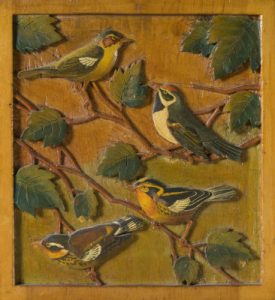calsfoundation@cals.org

Rohwer internee
mixed media
3.5 x 3 in.
c. 1942-1945
In 2010, Rosalie Santine Gould of McGehee donated her remarkable collection of artwork and other materials from the World War II-era Japanese American internment camp at Rohwer to the Butler Center for Arkansas Studies, a department of the Central Arkansas Library System. There were ten such camps around the country, most in the western United States. Two were in Arkansas, at Jerome and Rohwer.
The collection includes several hundred paintings and other works of art produced by U.S. citizens of Japanese descent who were interned during World War II. The art had been created in the camp under the tutelage of high school art teacher Mabel “Jamie” Jamison Vogel, who collected and saved her students’ art in the years following the war. Vogel became a champion of preserving the camp – which was dismantled after the war and essentially vanished – and its story, and she passed the torch to her good friend Rosalie Gould.
Gould was named in Vogel’s will as the recipient of the entire collection, which includes hundreds of documents and photographs dealing with the schools, the “town” government, and many of the people who lived in the camp. A particularly important feature of the collection is a set of 185 handwritten autobiographies of internees dating from 1942. The collection is also noteworthy because the camp sent several hundred men to Europe as part of the U.S. Army’s famous 442nd Regimental Combat Team, which is said by many to have been the most highly decorated American combat unit of World War II. Camp newsletters and other documents attest to the pride internees at Rohwer took in the service these men offered their country.
Appraiser Jennifer Carman describes the materials Gould has given the Butler Center as “unique among internment collections” and cites experts who have said it contains artwork and documents that are “truly unmatched among objects in public collections.” The collection also includes a large amount of material documenting day-to-day life in the camp, which had its own school system, police department, and mayor.




